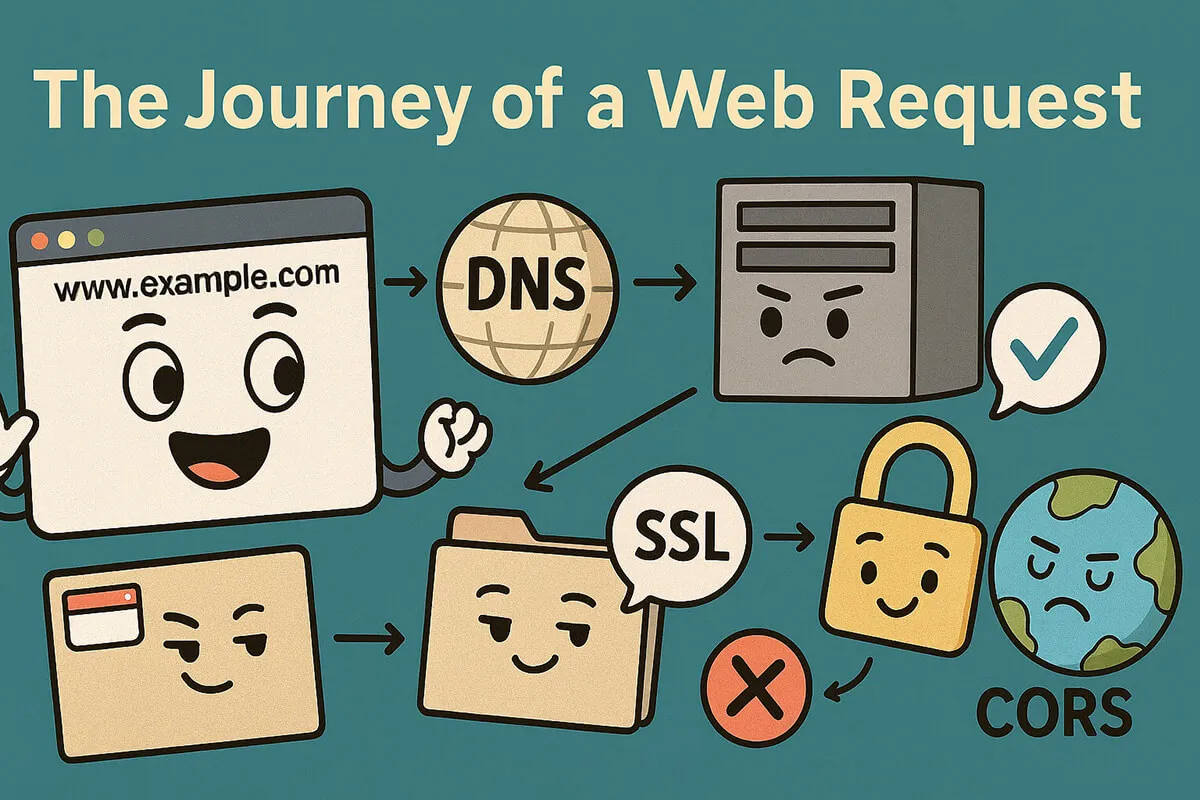The Secret Life of a Website Visit
A fun, story-style walkthrough of what really happens when you type a URL: DNS, TCP, TLS/SSL, HTTP, caching, rendering, CORS, cookies, CDNs, and more.

The Secret Life of a Website Visit 🌍✨
(or: Why your browser is basically a detective, courier, and diplomat all at once)
You type www.example.com into your browser and hit Enter.
A page appears in seconds.
Behind the scenes? A whirlwind of detectives, phonebooks, border guards, chefs, and bodyguards. Let’s follow the journey step by step.
🗺️ Scene 1: Finding the Address — DNS
Your browser only knows names like example.com, but the internet works on numbers (IP addresses).
- Browser cache → OS cache → DNS resolver.
- Resolver queries root → TLD (
.com) → authoritative server. - Finally, we get
example.com → 93.184.216.34.
Some browsers now use DNS-over-HTTPS (DoH) or DNS-over-TLS for privacy, and CDNs often serve DNS to route you to the nearest server.
🚦 Scene 2: The Road Trip — IP Routing
Now that we have an IP, data packets travel like cars:
- Hopping across routers, ISPs, and maybe undersea cables.
- Each packet is wrapped like an onion: IP → TCP → HTTP → Data.
- Packets may take different routes but arrive and reassemble in order.
If the site uses a CDN, you’ll probably hit a nearby edge server instead of the origin.
🚪 Scene 3: Knock Knock — TCP Handshake
Before talking, the browser knocks:
SYN → SYN/ACK → ACK
Connection is now open.
🤝 Scene 4: Secret Handshake — TLS/SSL
Before sending secrets, both sides agree on encryption.
- Server shows an SSL certificate (identity check).
- Browser verifies it (not expired, signed by trusted CA, matches hostname).
- Both agree on a cipher and exchange keys.
- Channel is now private — outsiders see only gibberish.
TLS 1.3 reduces round trips → faster handshakes, better security.
📜 Scene 5: Ordering the Pizza — HTTP Request
Your browser speaks first:
GET / HTTP/2
Host: example.com
User-Agent: Chrome/126.0
Accept: text/html
Accept-Encoding: gzip, br
Cookie: session=abc123The server responds with a status code, headers, and body:
200 OK→ here’s your HTML.301/302→ redirect.404 Not Found→ oops, no page.500→ server broke.
Cookies and tokens identify you (logged in, preferences).
Modern apps often use JWTs or OAuth tokens in headers.
🥡 Scene 6: Don’t Reorder the Same Toppings — Caching
Why redownload assets every time?
- Browser cache stores logos, CSS, JS.
- CDNs serve cached content closer to you.
- Cache headers tell when to reuse vs revalidate:
Cache-Control: public, max-age=604800
ETag: "abc123"If unchanged, server replies: 304 Not Modified (fast!).
👩🍳 Scene 7: Kitchen Drama — Rendering
The browser is now the chef:
- Parse HTML → DOM
- Parse CSS → CSSOM
- Build Render Tree
- Layout → Paint → Composite
JavaScript can change things mid-flight (React/Vue updates the DOM).
Optimizations: minified assets, preloading, lazy loading, compression (Gzip/Brotli), HTTP/2 multiplexing.
🕶️ Scene 8: The Overprotective Bouncer — CORS
Your page asks another domain for data. The browser checks:
Access-Control-Allow-Origin: https://example.comIf yes → allowed. If not → request blocked for safety.
That’s CORS — preventing shady cross-site tricks.
🪪 Scene 9: Memory Keeper — Cookies & Storage
Websites remember you using:
- Cookies: session IDs, login state.
- LocalStorage / IndexedDB: larger storage for apps.
- Tokens: JWTs in headers for APIs.
Security flags matter:
HttpOnly, Secure, SameSite, Path, Max-Age.
🛡️ Scene 10: Hidden Bodyguards — Security Headers
Beyond TLS, sites add helmets:
- HSTS: force HTTPS always.
- CSP: stop rogue scripts (XSS).
- X-Frame-Options: prevent clickjacking.
- SameSite cookies: stop CSRF.
⚙️ Scene 11: Hidden Superpowers
- Service Workers: offline caching, push notifications.
- HTTP/2 + HTTP/3 (QUIC): multiplexing, fewer round trips.
- Load Balancers: distribute traffic across servers.
- CDNs: edge caching, DDoS protection.
❌ Scene 12: What If Something Goes Wrong?
- DNS fails →
ERR_NAME_NOT_RESOLVED. - Timeout → fallback server or retry.
- Service worker may serve cached offline page.
- If TLS cert is invalid → scary browser warning.
✨ Scene 13: Voilà — The Feast
After DNS lookups, IP routing, TCP, TLS, HTTP, caching, rendering, CORS, cookies, security checks, and optimizations… the final page appears in milliseconds.
What looked like a simple click was actually hundreds of tiny conversations happening worldwide.
🔁 Recap in One Breath
- DNS finds the address.
- IP routing carries packets.
- TCP + TLS secure the lane.
- HTTP requests/serves content.
- Caching avoids duplicates.
- Rendering cooks pixels.
- CORS enforces boundaries.
- Cookies/tokens remember you.
- Security headers keep you safe.
- Optimizations + error handling make it smooth.
Next time you hit Enter on a URL, remember: it’s not magic — it’s a beautifully choreographed dance of networking concepts. 💃🌍